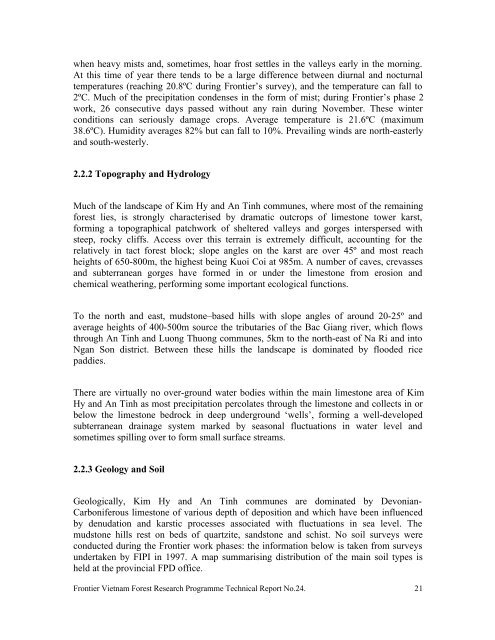Kim Hy Proposed Nature Reserve - Frontier-publications.co.uk
Kim Hy Proposed Nature Reserve - Frontier-publications.co.uk
Kim Hy Proposed Nature Reserve - Frontier-publications.co.uk
You also want an ePaper? Increase the reach of your titles
YUMPU automatically turns print PDFs into web optimized ePapers that Google loves.
when heavy mists and, sometimes, hoar frost settles in the valleys early in the morning.<br />
At this time of year there tends to be a large difference between diurnal and nocturnal<br />
temperatures (reaching 20.8ºC during <strong>Frontier</strong>’s survey), and the temperature can fall to<br />
2ºC. Much of the precipitation <strong>co</strong>ndenses in the form of mist; during <strong>Frontier</strong>’s phase 2<br />
work, 26 <strong>co</strong>nsecutive days passed without any rain during November. These winter<br />
<strong>co</strong>nditions can seriously damage crops. Average temperature is 21.6ºC (maximum<br />
38.6ºC). Humidity averages 82% but can fall to 10%. Prevailing winds are north-easterly<br />
and south-westerly.<br />
2.2.2 Topography and <strong>Hy</strong>drology<br />
Much of the landscape of <strong>Kim</strong> <strong>Hy</strong> and An Tinh <strong>co</strong>mmunes, where most of the remaining<br />
forest lies, is strongly characterised by dramatic outcrops of limestone tower karst,<br />
forming a topographical patchwork of sheltered valleys and gorges interspersed with<br />
steep, rocky cliffs. Access over this terrain is extremely difficult, ac<strong>co</strong>unting for the<br />
relatively in tact forest block; slope angles on the karst are over 45º and most reach<br />
heights of 650-800m, the highest being Kuoi Coi at 985m. A number of caves, crevasses<br />
and subterranean gorges have formed in or under the limestone from erosion and<br />
chemical weathering, performing some important e<strong>co</strong>logical functions.<br />
To the north and east, mudstone–based hills with slope angles of around 20-25º and<br />
average heights of 400-500m source the tributaries of the Bac Giang river, which flows<br />
through An Tinh and Luong Thuong <strong>co</strong>mmunes, 5km to the north-east of Na Ri and into<br />
Ngan Son district. Between these hills the landscape is dominated by flooded rice<br />
paddies.<br />
There are virtually no over-ground water bodies within the main limestone area of <strong>Kim</strong><br />
<strong>Hy</strong> and An Tinh as most precipitation per<strong>co</strong>lates through the limestone and <strong>co</strong>llects in or<br />
below the limestone bedrock in deep underground ‘wells’, forming a well-developed<br />
subterranean drainage system marked by seasonal fluctuations in water level and<br />
sometimes spilling over to form small surface streams.<br />
2.2.3 Geology and Soil<br />
Geologically, <strong>Kim</strong> <strong>Hy</strong> and An Tinh <strong>co</strong>mmunes are dominated by Devonian-<br />
Carboniferous limestone of various depth of deposition and which have been influenced<br />
by denudation and karstic processes associated with fluctuations in sea level. The<br />
mudstone hills rest on beds of quartzite, sandstone and schist. No soil surveys were<br />
<strong>co</strong>nducted during the <strong>Frontier</strong> work phases: the information below is taken from surveys<br />
undertaken by FIPI in 1997. A map summarising distribution of the main soil types is<br />
held at the provincial FPD office.<br />
<strong>Frontier</strong> Vietnam Forest Research Programme Technical Report No.24. 21
















